In Persia, walnuts had an association with royalty. Likewise, ancient Greeks and Romans considered them food for the gods. When Mount Vesuvius erupted and turned the city of Pompeii into a historical still life in 79 CE, it preserved whole, unshelled walnuts as part of a meal in the temple of Isis. And in China, walnuts are prized both as status symbols and toys, with their size and color determining their value. So why were walnuts so revered throughout history?
The doctrine of signatures says that plants that resemble a condition or body part can in some way treat or alleviate related illnesses. Following that thinking, walnuts, which look like brains, were thought to ease headaches and mental health issues. Similarly, the scarlet roots of bloodroot were thought to treat diseases of the circulatory system. And since ginseng root looks like a human being, it was thought to aid and strengthen all parts of the human body. Indeed, the very word “ginseng” comes from the Chinese word for “man-root.”
But the doctrine of signatures is controversial and based on theory over scientific fact. So is it true that walnuts are actually good for brain health? What other walnut health benefits are there? And are walnuts good for the environment?
What Are Walnuts?
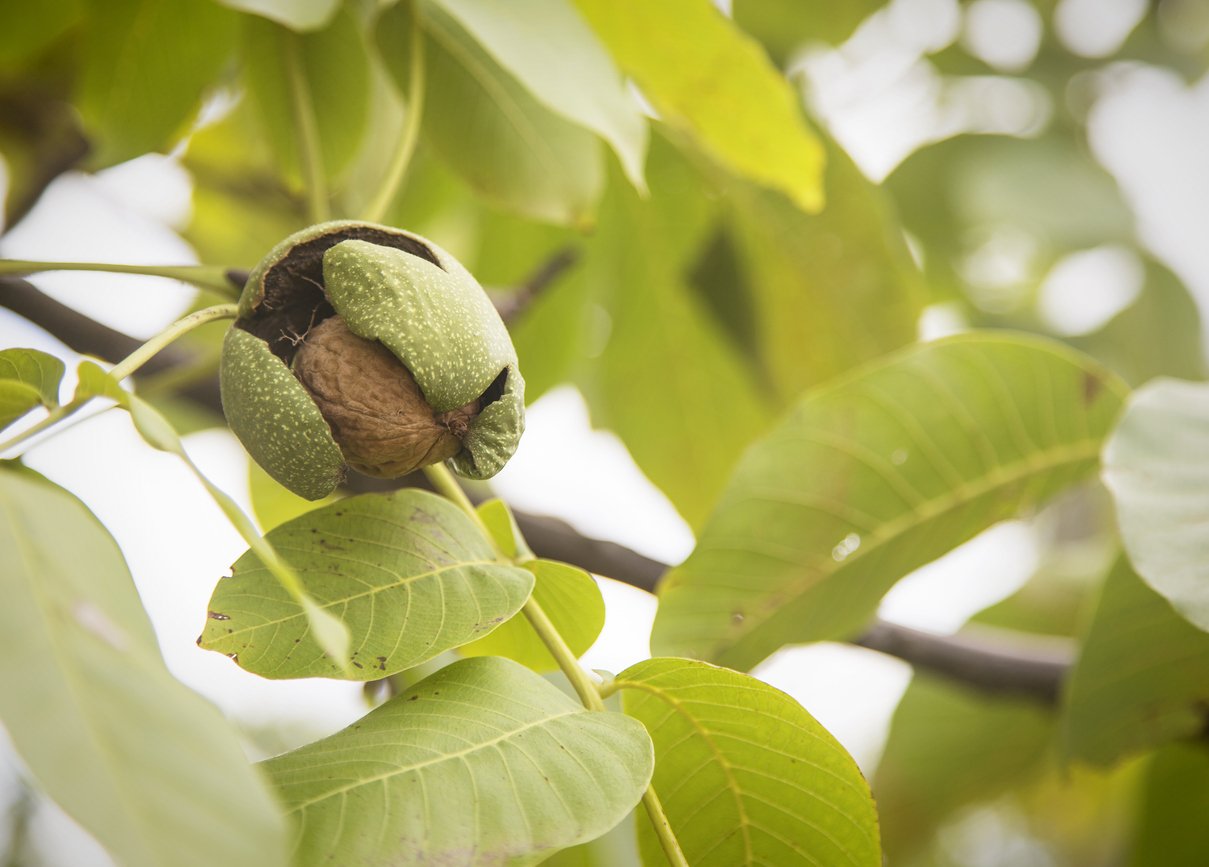
If you’re a word lover, you might enjoy adding “juglandaceous” to your vocabulary, in case you were missing a word for “of or pertaining to walnuts.” Walnuts are tree nuts that are proud members of the Juglans genus, along with about 20 other tree species, including hickories and pecans.
Technically, walnuts can be classified as nuts or dry drupes, which is science’s alliterative way of talking about fruits with a single seed and a dry husk. Walnuts grow in groups of two or three and range between 1.5 and 2 inches in circumference.
The nut of the walnut forms inside a soft green outer husk and a hard shell. Crack that shell open carefully enough, and you’ll behold a whole walnut that resembles a human brain — including wrinkles, folds, and ridges.
Types of Walnuts
There are two main types of walnuts that you’re likely to encounter in your culinary adventures: English walnuts (also known as Persian), and black walnuts.
English or Persian Walnuts
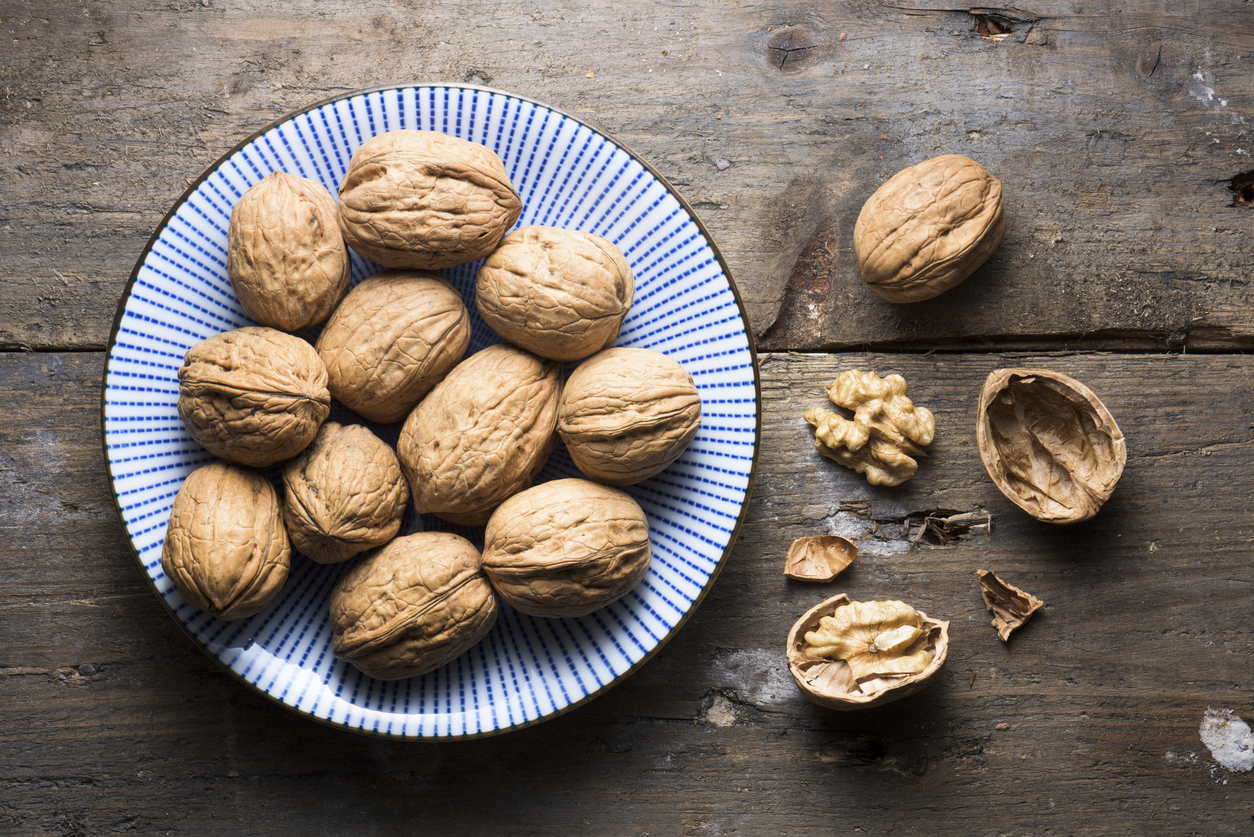
English walnuts are the kind most walnut-eaters are familiar with, as they’re the type you’re likely to see in grocery stores. They have a sweet, mild flavor, and feature prominently in desserts, salads, and many savory dishes.
Although Persian walnuts originated in what is now Iran, they’re often referred to as English walnuts because they were brought to England by the Romans and traded throughout Europe. Since then, their popularity has led to them being grown commercially worldwide.
In the US, English walnut trees grow best in USDA Zones 4–8 (a classification system that tells farmers and gardeners which plants are hardy enough to thrive in various locations). More than 99% of US commercially grown English walnuts come from California, which supplies about half of the world’s walnut trade. Romania has become the main producer and exporter of walnuts in Europe.
Black Walnuts
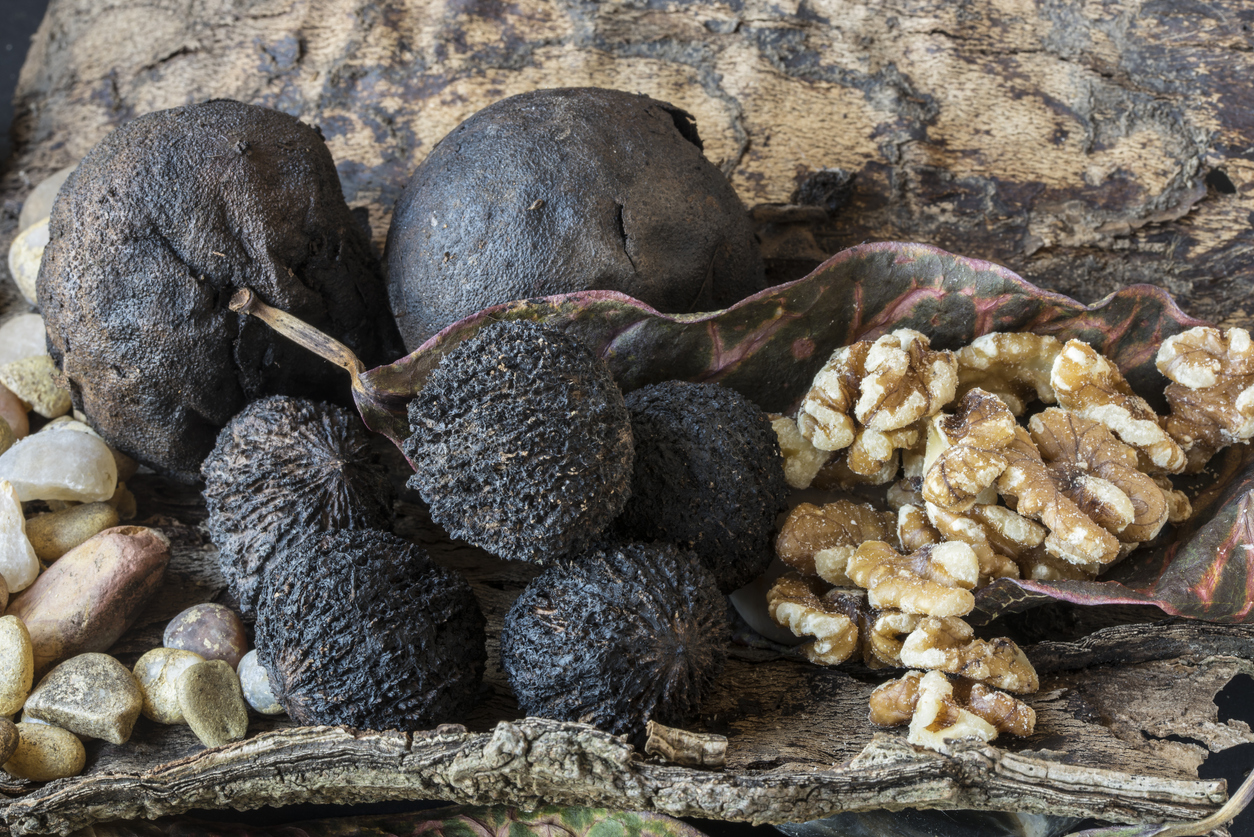
Black walnuts are native to North America, and almost all of them come from trees growing in the wild rather than in commercial orchards. Since black walnut trees don’t grow in neat, evenly-spaced rows, they’re harvested by hand rather than by machine. The largest black walnut processor is Hammons Black Walnuts in Missouri.
Black walnuts are bolder and sweeter than English walnuts, with a distinctive earthy or musky flavor. These nuts were and are an important part of Indigenous diets in the regions where they grow. It takes a lot of effort to harvest and remove their tough green husks and then crack open their extremely hard, black-ridged shells. There are even specialty nutcrackers made just for black walnuts.
In addition to eating black walnuts, you can use them for their oil, and for making deep black or brown dyes.
Walnut Nutrition
Like other tree nuts, walnuts are a healthy part of a balanced diet. They’ve been an important source of plant-based fat and protein throughout much of recorded human history. Walnuts contain polyunsaturated fat in the form of omega-3 and omega-6 fatty acids, including roughly 2.5 grams per ounce of alpha-linolenic acid (ALA). Omega-3s can also reduce the risk of heart disease, contribute to brain and immune health, and bring anti-inflammatory benefits to the body.
Walnuts are high in B vitamins and are a rich source of minerals, including magnesium, phosphorus, manganese, and copper. Of all the tree nuts, walnuts are antioxidant champs, with higher concentrations than any other commonly consumed tree nut. As a whole plant food, they’re also a solid source of fiber.
Black walnuts may pack an even more potent nutritional punch than English walnuts. They’re higher in zinc and selenium and contain more antioxidants and polyunsaturated fatty acids. Black walnuts share many of the same health benefits as their English cousins but are even better at fighting inflammation, as you’ll see below.
Walnut Health Benefits
Measuring the amounts of nutrients found in walnuts is all well and good, but what’s the effect of all that nutritional goodness on human health? There’s some powerful evidence on the health benefits of walnuts, showing that eating these humble nuts can benefit your heart, digestive system, and, yes, your brain. Walnut benefits may also include the ability to fight cancer and decrease chronic inflammation.
Read on to find out the details on what walnuts are good for and why.
Walnuts and Heart Health
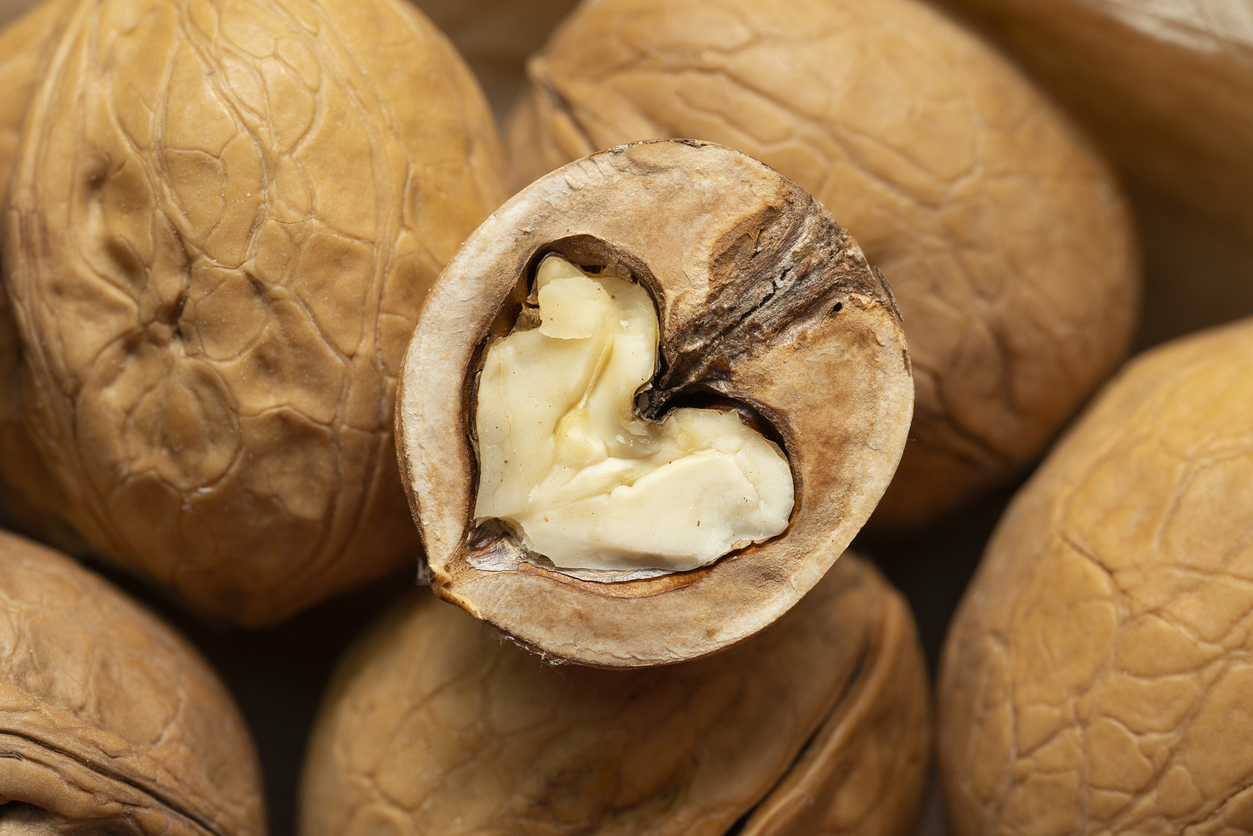
Are walnuts good for your heart? The evidence seems to suggest that they are!
A 2013 clinical trial found that people who added walnuts to their diet improved the health of their blood vessels. The addition also improved their cholesterol efflux, a process by which the body removes excess cholesterol from blood vessels. Both of these outcomes are beneficial for heart health.
A large study published in 2018 looked at health and dietary outcomes for over 200,000 participants, none of whom had heart disease at the start of the study. After following them for 25 years, about 14,000 of the participants experienced coronary events (heart attacks and strokes). But those who ate at least one serving of walnuts per week had a 13–26% lower risk of heart disease.
Since walnuts are high in calories, some people worry that they might contribute to weight gain and thus increase the risk of heart disease. A 2018 meta-analysis addressed that very concern.
Researchers looked at 26 studies that included over 1,000 participants, to see the effect that walnuts had on lipid levels, weight, and other heart disease risk factors. Their analysis showed that, on average, walnuts actually lowered total and LDL (“bad”) cholesterol, and didn’t impact weight one way or the other.
Walnuts and Digestion
Walnuts are also good for your gut health by promoting the growth of beneficial bacteria.
A 2018 study found that when healthy people started eating just 43 grams of walnuts a day, after eight weeks, their gut microbiomes became healthier and more diverse.
Another 2018 study found that eating walnuts increased concentrations of beneficial bacteria that produce a substance called butyrate, which is good for intestinal health. Additionally, walnuts can reduce the number of harmful substances produced by certain bacteria that can cause inflammation and increase “bad” LDL cholesterol.
Walnuts and Brain Health

Now we get to the brain. Are walnuts good for brain health as their shape might suggest?
A 2014 review article concluded that walnuts should be included in prevention strategies against the epidemic of cognitive decline and dementia. The phytochemical substances present in walnuts not only decrease oxidative stress and inflammation in brain cells but also boost communication between neurons, stimulate the formation of new neurons, and assist in the removal of harmful proteins associated with the development of dementia.
While human studies have repeatedly shown that diets that include walnuts are associated with improved cognitive performance and better memory, a 2020 mouse study explored the possible mechanisms for this. The study found that walnuts’ antioxidant and anti-inflammatory properties suppressed the production of free radicals and enhanced antioxidant protection, consequently lowering the risk of brain degeneration. (Our view on the use of animals in medical research is here.)
A 2022 article also reviewed some of the ways walnuts are known to combat neuroinflammation, a major contributor both to aging in general and to neurodegenerative diseases like Alzheimer’s in particular. It quickly got technical on me, with phrases such as “inhibition of peripheral inflammation mediated by macrophages.” But the bottom line is that walnuts appear to reduce neuroinflammation through a number of synergistic biochemical mechanisms.
After all that evidence, walnuts seem to look like brains because they support neuronal health and fight neuroinflammation. Maybe there is something to the doctrine of signatures after all!
Walnuts and Cancer
A 2019 clinical trial studied the impact of walnut consumption on breast cancer growth and survival. Women with confirmed breast cancer cases were divided into two groups, one whose members began eating two ounces of walnuts daily after their initial biopsy, and a control group that did not change their diet.
After about two weeks, further samples were taken from the tumors. In the walnut-consuming group, the expression of 456 specific genes in the tumor was significantly altered to encourage cancer cell death and suppress cell growth and migration processes. This supports the idea that eating walnuts could potentially slow the growth of cancer cells and increase breast cancer survival rates.
A 2020 study found that black walnuts also demonstrate impressive anticancer activity, thanks to compounds such as penta-O-galloyl-β-d-glucose and quercetin 3-β-d-glucoside. I tried to remember the names of these compounds by putting them to the tune of “Supercalifragilisticexpialidocious,” but I couldn’t get the syllables to match.
Walnuts and Inflammation

Walnuts are also good for fighting inflammation. Black walnuts, in particular, show amazing anti-inflammatory powers. Two cultivars, named Surprise and Sparrow, demonstrated the ability to suppress inflammatory human white blood cells in a 2019 test-tube study.
But common English walnuts are no slouches in the anti-inflammatory department, either. In 2020, researchers published the results of a two-year trial in which one group of older adults consumed roughly 15% of their daily calories from walnuts, while others ate a similar but walnut-free diet. They found that the walnuts had a health-promoting effect on several inflammatory molecules implicated in cardiovascular disease.
Walnuts may battle inflammation through a compound known as ellagitannins, which can do some very cool anti-inflammatory things. It breaks down in your body to release another compound called ellagic acid. And your gut bacteria then transform this into substances called urolithins, which may have strong anti-inflammatory properties.
Are Walnuts Sustainable?
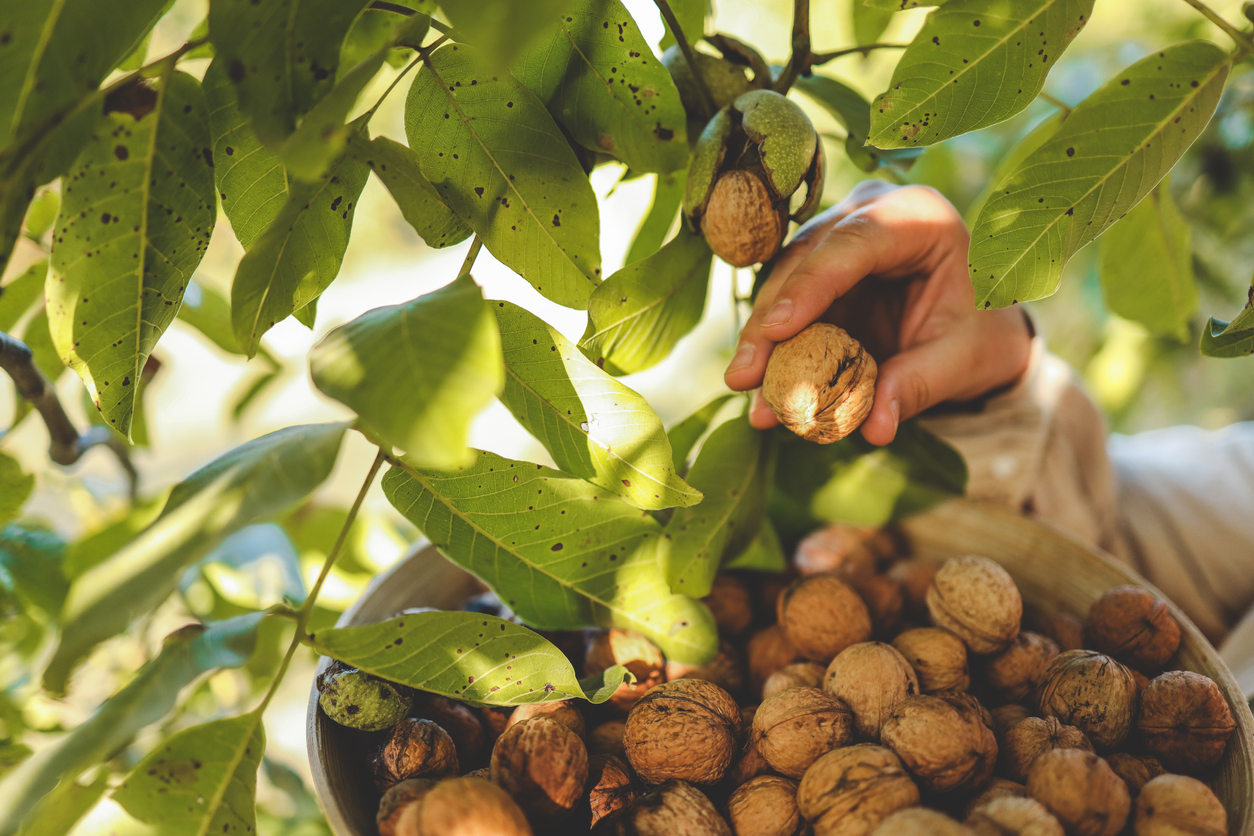
In general, nuts and other plant-based protein sources produce far fewer greenhouse gas emissions than animal-based food products. The main issue for walnuts is their need for water since half the English walnuts consumed in the world are grown in California — a state perennially vulnerable to drought.
Each pound of walnuts takes about 1,260 gallons of water, which is less than a pound of almonds or beef (which is kind of in a class by itself, requiring 2,400 gallons of water per pound), but still quite a bit — especially in a water-poor region.
However, walnut trees can also benefit the environment in some important ways. Walnut plantations studied in China increased soil carbon and promoted microbial growth and activities.
And black walnuts are potentially even more sustainable, at least on a small scale, since they are wild-grown and harvested by hand. They require no pesticides and don’t need fossil-fuel-driven machines for harvesting.
Walnut shells also have many industrial uses, some of which are being explored to replace less environmentally friendly alternatives. For example, the shells are being added to substances called geopolymers that can make highly effective insulation.
Walnut shells also have uses as gardening mulch and ground cover, animal bedding, ingredients in the manufacture of activated carbon, abrasive elements in cleaning products, and an energy source for bioethanol production.
Walnuts for the Win
Walnuts are an important tree nut and have been for thousands of years. Their impressive nutritional profile makes them a standout for both culinary purposes and medicinal uses. These hearty nuts are a rich source of healthy fats and protein.
Walnuts are, indeed, good for you as they’ve been found to have benefits for heart, brain, and digestive health, as well as in fighting cancer and inflammation. And while they do use a lot of water, walnuts can also be good for the environment by pulling carbon into the soil.
Are you a walnut fan?
Tell us in the comments:
- What are your favorite ways to enjoy walnuts?
- What surprised you the most about the health benefits of walnuts?
Featured Image: iStock.com/aslanyus



